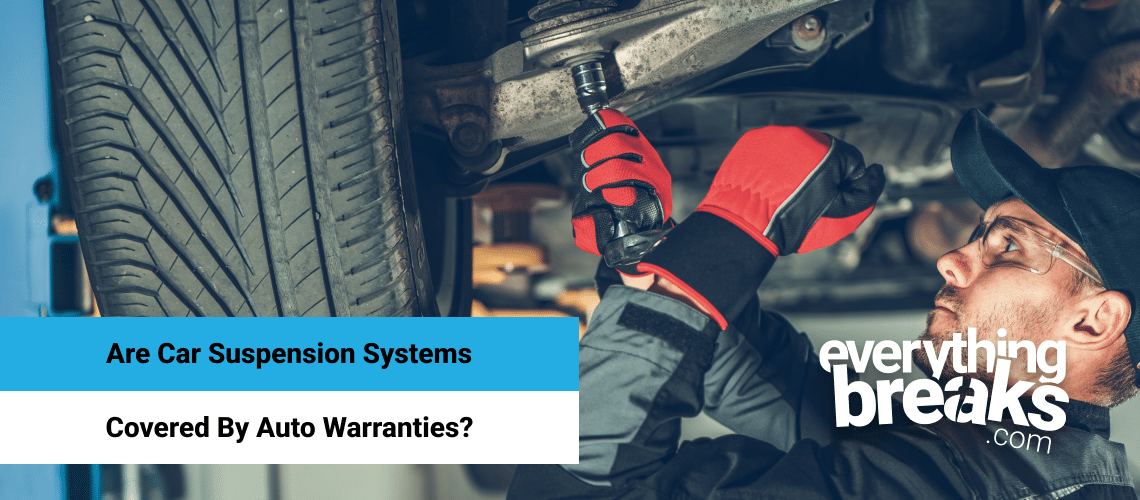Your vehicle’s suspension system guarantees a lot more than a smooth ride. It helps you maintain control while driving, making it a critical part of your car’s safety and performance. But what happens when your suspension system starts to fail? Are repairs covered by auto warranties, or will you be left with a hefty bill?
The Major Components of Vehicle Suspension Systems
A vehicle’s suspension system is made up of several interconnected components, each working together to absorb shock, maintain tire contact with the road, and provide steering stability. The key parts of the suspension system include:
- Shocks and Struts: these components absorb the impact from road bumps and help maintain a smooth ride.
- Control Arms: these link the vehicle’s frame to the wheels, allowing for controlled motion of the suspension.
- Ball Joints: these act as pivot points between the wheels and suspension, providing flexibility while steering and driving over uneven terrain.
- Springs: these support the weight of the vehicle and absorb shock from the road.
- Bushings: rubber or polyurethane parts that reduce friction between metal components.
- Sway Bars: also known as anti-roll bars, these help reduce body roll when turning corners.
Each of these components works together to provide a comfortable and controlled driving experience. However, over time, wear and tear can cause these parts to deteriorate, leading to costly repairs.
What Are the Most Common Suspension Issues and How Much Do They Cost?
Suspension problems are common as vehicles age, especially if they frequently drive on rough terrain or poorly maintained roads. Some of the most common suspension issues include:
- Worn Shocks or Struts: when shocks or struts wear out, the vehicle may bounce excessively or have trouble maintaining tire contact with the road. Replacing shocks or struts can cost between $400 and $1,000, depending on the vehicle.
- Broken Control Arms: damaged control arms can lead to poor steering control and tire misalignment. Replacing a control arm typically costs between $200 and $600.
- Worn Ball Joints: worn-out ball joints can cause clunking noises when turning or going over bumps. Replacing ball joints may cost between $200 and $500, depending on labor costs and the specific vehicle.
- Damaged Springs: broken or sagging springs can affect the ride height and handling of the vehicle. Spring replacements generally cost between $350 and $700.
- Sway Bar Issues: sway bar links or bushings can wear out, leading to poor stability during turns. Replacing these parts can cost between $100 and $300.
Regular maintenance can help prevent sudden failures, but even with the best care, parts of the suspension system may eventually need to be replaced.
The Dangers of Not Repairing a Vehicle Suspension System
Neglecting suspension repairs can lead to more than just a rough ride—it can create dangerous driving conditions. Here are some potential dangers of driving with a damaged suspension:
- Reduced Control: a malfunctioning suspension system can make it difficult to control your vehicle, especially when turning or braking. This can lead to accidents, particularly in emergency situations.
- Increased Tire Wear: a failing suspension can cause uneven tire wear, reducing the lifespan of your tires and increasing the risk of a blowout.
- Longer Stopping Distances: worn shocks or struts can increase your vehicle’s stopping distance, making it harder to avoid collisions.
- Damage to Other Components: a faulty suspension system can place undue stress on other parts of your vehicle, such as the brakes and steering components, leading to further costly repairs.
Which Suspension Components are Covered in an Auto Protection Plan?
The suspension components covered in our Topline Auto Protection Plan include:
- Suspension Level Control Compressor
- Leaf Springs
- Coil Springs
- Hub Assembly
- Torsion Bars
- Wheel Bearings
- Stabilizer Bar, Arm, and Bushings
- Radius Arm and Bushings
- King Pins and Bushings
- Ball Joints
- Spindles
- Wheel Bearings
- Bearings and Bushings
- Upper and Lower Control Arm Shafts
- Traction Control Switch
- Lateral Accelerometer
How an Extended Service Contract Can Save Money on Suspension Repairs
While factory warranties typically cover major vehicle components, many only last a few years or up to a certain mileage. Once your factory warranty expires, you may be responsible for costly repairs, including suspension work. However, an extended service contract (also known as an auto protection plan) can help offset these expenses.
Extended service contracts often cover a wide range of mechanical failures, including suspension system repairs. Depending on the specific contract, you may have coverage for key suspension components like shocks, struts, control arms, and bushings. With this type of coverage, you can avoid paying out of pocket for expensive repairs, saving you hundreds or even thousands of dollars in the long run.
Cover Your Vehicle’s Suspension System Today
Whether you’re dealing with worn shocks, broken control arms, or another common suspension issue, repairs can quickly become expensive. However, with an extended service contract, you can protect yourself from the financial burden of suspension repairs, ensuring that your vehicle remains in optimal condition without breaking the bank.
Get in touch with us today to learn more about our auto protection plans!








